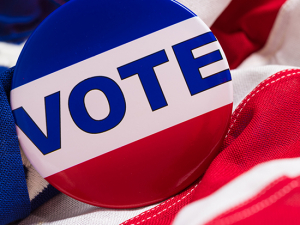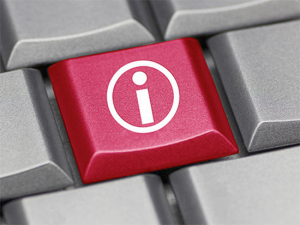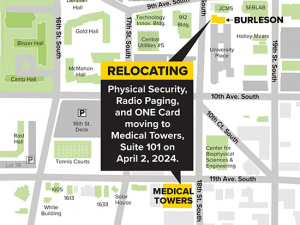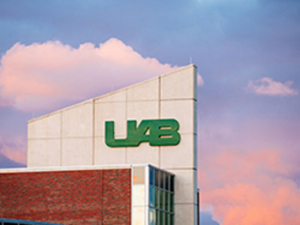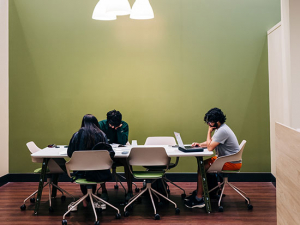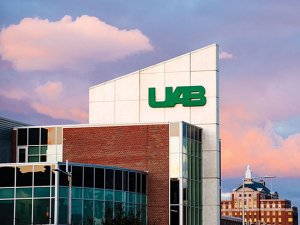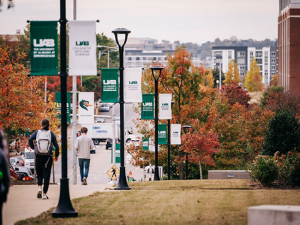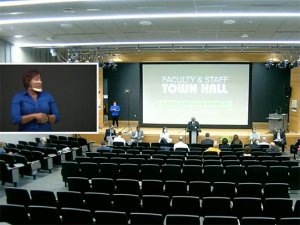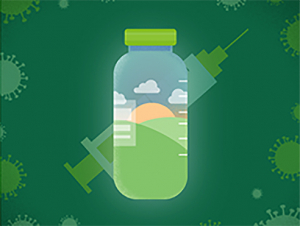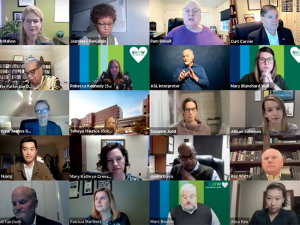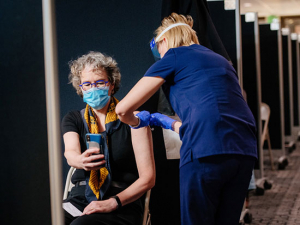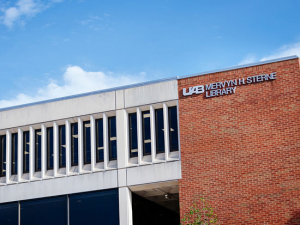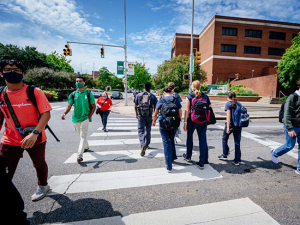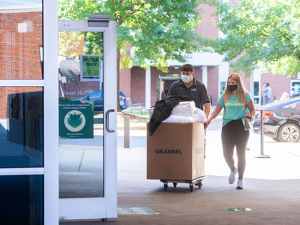In a virtual town hall Jan. 8 (watch the full video below), President Ray Watts, Provost Pam Benoit, School of Medicine Dean Selwyn Vickers, UAB Medicine CEO Reid Jones and other senior leaders provided updates and data on the COVID-19 vaccine rollout, spring semester plans and more.
“UAB has come a long way since the beginning of this pandemic,” Watts said. “We’ve all worked hard to keep moving forward, and what we’ve accomplished in 2020 is truly remarkable. Thank you for doing your very important part throughout this process. Challenges remain for us as a university and as a health system. But we’re in better shape than most of our peers across the nation. I have great optimism for us in 2021. I know that any challenge that presents itself, we can handle and we’ll successfully manage.”
Employees submitted dozens of questions and comments before and during the hour-long event. Many were answered in the town hall. These are summarized below, along with responses from senior leaders to all questions that could not be answered live due to time constraints.
Scroll down to read the complete summary or use the links below to jump to specific topics
Decisions on sequencing of employees to receive vaccination
‘How you know when it’s your turn’
Responses to questions not answered live due to time constraints
Responses to questions not answered live due to time constraints
Diversity, equity and inclusion
Responses to questions not answered live due to time constraints
UAB/Ascension St. Vincent’s alliance
Responses to questions not answered live due to time constraints
Responses to questions not answered live due to time constraints
Hiring suspension and expense-reduction strategies
Responses to questions not answered live due to time constraints
Working from home and staff well being
Responses to questions not answered live due to time constraints
Vaccines
“It’s my privilege to talk to everybody about the COVID vaccine,” said Sarah Nafziger, M.D., medical director for UAB Employee Health. “A month ago, almost to the day, is when we found out we would get some doses here at UAB” of the Pfizer/BioNTech vaccine, she said. “That was an exciting day. The first allocation was just under 11,000 doses and we were very happy to learn that.” In fact, that was “10 times more than we thought we would get initially,” Nafziger said. “We were planning to vaccinate our employees at UAB, but the [Alabama Department of Public Health] said, ‘We want you to also vaccinate a lot of other people in the community.’” (Find out more about the distribution of UAB’s initial shipment of vaccine doses on the UAB United site here.)
Organizing such an endeavor is “quite complicated,” Nafziger said, involving communication with hospitals, EMS providers and others around the region. Non-UAB recipients received their vaccine doses in a drive-through site at UAB Highlands Hospital. UAB employees are receiving their vaccine doses in the Margaret Cameron Spain Auditorium.
Doses administered so far
UAB has administered those initial doses to UAB Medicine employees and hospital and clinical personnel from a seven-county region in a 40-mile radius of UAB. As of the morning of Jan. 8, “we had administered 7,700 doses to UAB employees,” Nafziger said. Those all represent first doses of the two-dose schedule for the Pfizer/BioNTech vaccine, which must be given at least 21 days apart, Nafziger noted.
Safety and efficacy
Nafziger said she had received many questions about the efficacy and safety of the vaccine. After two doses, the vaccine has shown greater than 95% efficacy in clinical trials, she said. “We’re really excited about that. How long does the immunity last? We don’t know. It’s not been around long enough to know. The antibody levels in patients are remaining high. We hope that it lasts a long time, but we don’t know yet. We’ll be watching that.”
As for safety concerns, “the data shows that it’s very safe,” Nafziger said. “We’ve vaccinated over 12,000 people [at UAB] and we systematically collect data on all of [them]. We send them a survey after 24 hours and seven days.” After 24 hours, recipients have reported “mild, flu-like symptoms, fatigue, joint pain, headache and a sore arm,” Nafziger said. “One week after vaccination, nobody really has symptoms. We feel good about the safety data. We’ve had no allergic reactions or any events or injury from the vaccine.”
Decisions on sequencing of employees to receive vaccination
How will the vaccine be administered to different groups of employees moving forward, and who is deciding which employees fall in which categories? “We have to play by the rules that the [Alabama Department of Public Health] gives us,” Nafziger explained. As of Jan. 8, UAB was in Phase 1a, which includes health care workers and residents of long-term care facilities. (UAB is only vaccinating health care workers; other entities are handling vaccinations for long-term care facilities.) “We had directions about who to focus on first,” Nafziger said: “health care workers taking care of COVID patients on the front lines… and emergency front-line workers.”
UAB did have some discretion on distribution within those parameters. “I want to assure you that this is not something that we took lightly,” Nafziger said. “We had a committee looking at the sequencing of the vaccine and had it reviewed by our ethics personnel…. We put a lot of thought into sequencing this. Some people said, ‘You should vaccinate all the doctors and nurses.’ But health care is a team sport. There are a lot of people who work here every day, not just doctors and nurses…. A lot of people from all walks of life come here to deliver health care, so we took a broad focus.” That includes food and nutrition workers, therapists “and anybody at risk of coming in contact with these [COVID] patients,” Nafziger said. “We got permission from the state health officer to include the clinic-based students…. we’ve been working with the deans of the schools to identify those students to be able to extend vaccination invitations…. That’s something that has happened very recently.”
‘How you know when it’s your turn’
“I want to talk to you about the invitation process and how you know when it’s your turn,” Nafziger continued. “We had a lot of people we wanted to vaccinate quickly and wanted to be sure we got the people working in the COVID areas first…. We identified groupings of people from Human Resources and extended an invitation to their work email with a link to register to receive the vaccine.”
By Jan. 6, “we were able to open up the all-call area for health care workers,” Nafziger said. “We sent out [an email] that defines who health care workers are and what people are eligible to receive the vaccine right now. So, if you are a UAB employee and that applies to you, you can go online and register to receive the vaccine” through a link included in that email. “Once you do that, we schedule an appointment and you get an email with the appointment time. Once you receive the appointment, there’s a method to change that if you need to, but we want individuals to try their very best to make it to their appointment time so we don’t have to change it. It slows things down and it’s extra work for us. Our goal is being fast. We want everyone vaccinated as quickly as possible with no delays.”
Once the Phase 1a group is completed, “the next phase is Phase 1b and that includes people over the age of 75, first responders, people who live in congregant living situations like prisons…. and then front-line essential workers,” Nafziger said. This includes the education sector, as well as “corrections officers, firemen, police officers, people that work in food and agriculture, postal service, public transit and child-care workers. That’s where the remainder of campus will fall. When we get to Phase 1b, we’ll be able to offer it to everyone employed at UAB.”
When will that happen? At this point, “I can’t tell you an exact date because it not up to me,” Nafziger said. “As long as we get the green light from the Alabama Department of Public Health, we’ll be able to offer it to all of you…. Everyone that wants to get the vaccine will have an opportunity soon. We’re moving very quickly. We’re able to vaccinate over a thousand people per day. We’ve administered 12,000 doses. We’ll get through it super-fast. Hang in there. Stay tuned to the channels and we’ll give you information on when to sign up. Check your emails.”
UPDATE (1/14/2021):
Recent Alabama Department of Public Health guidance has indicated that groups within ADPH Phase 1b (e.g., ages 75+ and educators) will be prioritized differently to receive vaccines. As a result, some groups in 1b will get their vaccines before others, and UAB employees (who fall in the education sector) will be delayed. UAB does not believe it will be approved to vaccinate its employees broadly as soon as was anticipated at the time of the town hall. Our ability to broadly vaccinate UAB employees (and eventually students) depends on ADPH approval/guidance (re: the education sector) and sufficient vaccine supply. We will continue to provide updates to the campus community as they are available.
Nafziger answered several common questions she has received about the vaccine.
Is the vaccine mandatory?
“The vaccine is not mandatory,” Nafziger said. “It’s on an emergency use license from the FDA and it is brand new. We don’t feel we can mandate it. We’re highly encouraging all of our employees to get it. We want to keep you safe, your families safe and our campus safe. It’s an individual decision, for sure.”
Is there any chance of signing up to receive the vaccine on a stand-by basis?
“A lot of people have asked about stand-by availability,” Nafziger said. “This vaccine requires special storage and handling. It’s different than flu vaccine. A lot of special things have to be done to store it.” The vaccine requires special freezers and comes in powder form, Nafziger said, “and we have to mix it and draw it out in a vial… once you mix it, you have a finite amount of time before you waste [it] and we never want to waste a dose.”
If at the end of a day “we have extra doses of vaccine… we find people in the Phase 1a grouping” and offer them the chance to receive the vaccine immediately, Nafziger said. “There were days over the holidays — because people were not checking emails and missed their appointment times — where we had to call more broadly for stand-by availability. We did not want to waste doses. [So] we called the clinical leadership teams and asked them to send people in the target groups… to us to be vaccinated.”
What if I get the vaccine and I feel bad the next day — do I report the symptoms in Healthcheck?
“We ask that you not report the anticipated side effects for 72 hours after the vaccine,” Nafziger said. “We don’t want you to come to work if you have a fever. But if you have the expected side effects from the vaccine, you don’t need to report them in Healthcheck if it’s in the first 72 hours of receiving the vaccine. If it’s beyond 72 hours, we want you to report that.”
Is the vaccine safe if you are immunocompromised?
“We do believe that it’s safe for people that are immunocompromised,” Nafziger said. “The only ones that should hold off are those that have had serious allergic reaction to another vaccine.”
Will the vaccine be available for spouses of UAB employees?
“Only if the spouse is an employee” as well, Nafziger said. “Spouses would be part of the general public. When they are available for patients in the general public, that messaging will go out. We’ll let you know when it’s available.”
How long does it take after the vaccine shot to become protected?
“When you get the vaccine, there’s no magic that you have happening that day,” Vickers said. “The effectiveness of the vaccine occurs about two weeks after the dose. There are plenty of people that get the vaccine and within three days they get infected. The first dose can be as high as 80% effective, but it takes 10 days to two weeks. Don’t do behaviors that are unsafe because you got a shot that day.”
Is sentinel testing necessary if we have the vaccine or should we still get tested?
“Right now we’ve not changed our recommendations of testing based on the receipt of vaccine,” Nafziger said. “We may change that in the future. [But for now] we’re recommending sentinel testing even if you are vaccinated.”
Responses to questions that could not be addressed live due to time constraints:
Will older UAB employees be prioritized over younger ones, once we get to that phase?
Logistics of delivering vaccine beyond ADPH’s Phase 1a are being worked out now and will be communicated to campus as soon as possible. Please visit uab.edu/uabunited/covid-19-vaccine for the latest.
Can faculty teaching in-person classes be prioritized for early vaccination? Our vulnerable position puts us, our families and our students at higher risk of infection.
Based on testing and contact tracing data, we saw no evidence of student-to-teacher transmission in the fall semester, so we believe safety strategies in the classroom are effective. That said, we will vaccinate faculty as soon as we are able relative to guidance from ADPH and availability of doses, and logistics will be worked out. Updates will be communicated through official UAB emails and at uab.edu/uabunited/covid-19-vaccine.
Will graduate students be in Phase 1b? Many grad students were “essential” during the shutdown while their faculty advisors have worked remotely.
This depends on the role of the student (e.g., clinical, non-clinical, type of research, relative risk, etc.). Eligibility is based on duties of the student and in what settings they are. For example, ADPH is now allowing clinical students to be vaccinated, and invitations are going out to those groups.
Will invitations to the campus be sent first to those who disclose they are also high risk? Or will it be open to all campus employees at the same time, regardless of other factors?
Logistics of delivering vaccine beyond ADPH’s Phase 1a are being worked out now and will be communicated to campus as soon as possible. Please visit uab.edu/uabunited/covid-19-vaccine for the latest.
Is there any subdivision within Phase 1b (teaching in-person versus remote)?
Logistics of delivering vaccine beyond ADPH’s Phase 1a are being worked out now and will be communicated to campus as soon as possible. Please visit uab.edu/uabunited/covid-19-vaccine for the latest.
Are employees exclusively working from home included in the 1b group?
Sequencing is based on role, per the ADPH. Logistics for campus are still being worked out. Updates will be communicated through official UAB emails and at uab.edu/uabunited/covid-19-vaccine.
Why are non-clinical faculty in the School of Optometry getting vaccinated now?
We are now almost done vaccinating employees in the UAB clinical enterprise with on-site duties who want to be vaccinated. Optometry is considered part of the clinical enterprise and was reached at the appropriate time in the vaccine sequencing. As we completed vaccinations in the initial groups, eligibility opened up to others.
The official prioritization for vaccination I think is something everyone feels is fair and just. However, everyone in my part of campus (CAS) knows multiple individuals who fit none of the stated criteria yet have already been vaccinated. So this doesn’t really seem like such a rare problem. How can we ask our faculty and graduate students to repeatedly interact with students once the new semester starts, when they all know numerous people who never interact with students or patients or get near a hospital who have been vaccinated, when they haven’t?
Based on testing and contact tracing data, we saw no evidence of student-to-teacher transmission, or teacher-to-student transmission, in the fall semester, so we believe safety strategies in the classroom are effective. That said, we will vaccinate faculty as soon as we are able relative to guidance from ADPH and availability of doses, and logistics will be worked out. Updates will be communicated through official UAB emails and at uab.edu/uabunited/covid-19-vaccine.
There could be a number of reasons why someone was vaccinated who doesn’t appear to fit criteria:
- in order to avoid significant delays in vaccine rollout – which is in the best interest of public safety – eligibility was opened up to groups rather than individuals based on relative risk, duties and/or buildings in which they work (delaying to tease each individual out of approved groups would slow down vaccines to everyone);
- some criteria is loosely defined and may be interpreted differently;
- UAB is a complicated organization with employees that are coded in the system across multiple units, buildings and duties;
- no-shows at the vaccine site required limited instances of inviting groups or individuals immediately available to avoid wasting vaccine;
- a limited number of the first employees invited shared their vaccine invitation/link with other employees who had not yet been invited, and we have addressed the scheduling process so this can no longer happen.
There are other test sites outside of UAB. Can we take advantage of any opportunity to be vaccinated or do we have to wait until UAB can take us?
If you are offered a vaccine outside of UAB, you do not need to wait for UAB. Please alert Employee Health when you have completed your vaccination by emailing documentation to employeehealth@uabmc.edu.
Any idea when research staff who don’t directly have patient contact, but who work in/around patient care buildings will be vaccinated?
Some researchers are able to get vaccinated at this time. Please visit uab.edu/uabunited/covid-19-vaccine for the latest.
Is there a vaccination plan for clinical research people who at present are not able to do research in the clinical settings?
Some researchers are able to get vaccinated at this time. Please visit uab.edu/uabunited/covid-19-vaccine for the latest.
I am a COVID researcher but mostly work with recovered plasma and PBMC samples. Am I supposed to get the vaccine as opposed to someone like a health care worker or researcher who is in direct exposure to the virus?
You would not have been included in the initial, early rollout, but at this time we have progressed enough re: front-line workers that we encourage COVID researchers to get their vaccine. Please visit uab.edu/uabunited/covid-19-vaccine for the latest.
If someone turns down a vaccination opportunity because they believe that others need the vaccine more, does that slow the process any?
No, but we are now almost done vaccinating employees in the UAB clinical enterprise with on-site duties who want to be vaccinated, and it is important we vaccinate as many people as possible. If you are eligible and/or have been invited to get vaccinated, please check with Employee Health before turning down the vaccine for this reason.
Is UAB progressing through the ADPH phases independent of the rest of the state? You mentioned that we may switch to Phase 1b soon, but is that true for the whole state (i.e. that all health care workers are nearly done statewide)?
Based on vaccine allotments relative to the populations they serve, some vaccine sites will be able to reach different populations at different times. Some may start vaccinating 1b groups while others remain in 1a. All are required to follow ADPH guidance.
I am currently pregnant, and my doctor has advised I wait until giving birth to get the vaccine. Will I be able to get the vaccine after I give birth, even if it’s outside of the 1b window?
Once you are eligible, we anticipate you will remain eligible.
Will registered off-site volunteers have an opportunity to be vaccinated?
Some volunteers have been vaccinated. Eligibility is based on duties of the volunteer and in what settings they are performed. Please visit uab.edu/uabunited/covid-19-vaccine for the latest.
If I’ve never been tested, it’s true that I could be asymptomatic. How does this tie in to the 90-day rule for being vaccinated?
Per CDC recommendations, we do not screen for asymptomatic COVID-19 carriers prior to vaccination.
Are part-time employees at the bottom of the list?
Sequencing is based on role (per the Alabama Department of Public Health) rather than employment type (full or part time). Please visit uab.edu/uabunited/covid-19-vaccine.
I am being treated with therapy that depletes B cells. My MD has advised me to wait until right before my next six-month therapy dose. Can I make an appointment to receive the vaccine in May?
Once you are eligible, we anticipate you will remain eligible. Please do not attempt to make an appointment until you are ready to receive the vaccine.
Is there information about vaccine safety in children?
The currently available vaccine is not approved for children younger than age 16 at this time.
Are there any interactions with the Shingrix vaccine? I need to get my second dose soon.
We recommend that you not receive any other vaccines within two weeks of receiving the COVID-19 vaccine.
Will part-time UAB staff get the COVID-19 vaccine if over 65?
Sequencing is based on role (per the Alabama Department of Public Health) than employment type (full or part time). At this time, ADPH has prioritized ages 75+. Please visit uab.edu/uabunited/covid-19-vaccine for the latest on eligibility among UAB employees.
It was announced that spouses of employees would not be vaccinated by UAB. How about a spouse who is a patient of UAB Medicine? In fact, how does being a UAB Medicine patient relate to being a UAB employee in the plans for vaccinations? Many employees of UAB and their family are also “customers” (patients) of UAB. Please clarify. And how about another important category of UAB “customers,” namely students?
UAB Medicine is still in Phase 1a of Alabama’s COVID-19 vaccination plan, which calls for vaccinating clinical enterprise workers first, due to the limited amount of vaccine received to date. We are working on all of the logistics and necessary details to vaccinate those 75 and older (ADPH Phase 1b), as well as other groups outside of Phase 1a (which could include spouses, patients, students etc.), and we will communicate that plan as soon as it is finalized. UAB Medicine is working hard to get vaccines as quickly as possible, and we will continue to use all media forums — including direct patient communications — to update our community on when vaccinations will be available more widely.
On Jan. 9 I heard on the local TV news (NBC) that about half of the health care workers at UAB that were offered the vaccine refused it (“opted to wait,” was the language used, I believe). I wonder how we should interpret that fact and what it means for the health and risks to UAB employees, patients, and students.
Many people who did not initially sign up for a vaccine when invited have since circled back to get a vaccine. Some did not check their email for invitations during the holidays, and some wanted to see others get their vaccine first. Only about 4% of those invited declined. We will have a better idea of the situation and how it should be interpreted as we have more data.
What are the specifics of the role that UAB plays in statewide vaccinations? I submitted that question ahead of time but it was not fully answered during the town hall on Friday. Related to this, how does vaccinating “all employees,” as was announced during the town hall to happen sometime in the next month or so, fit in with the 1a-1d priority scheme of the state and/or the Alabama counties?
There are lots of nuances and unanswered questions as it relates to phases. For example, educators and those ages 75+ are both in Phase 1b. While ADPH has indicated that 75+ will be eligible soon, they have not yet made educators eligible. Upcoming decisions regarding these groups will affect our optimistic timeline re: UAB employees. In order to move toward vaccinating all employees, ADPH needs to open up vaccines to educators. At the same time, we need to receive allocations of vaccines, which will very likely be shared with other populations. As soon as ADPH allows us, we will vaccinate all employees who wish to be vaccinated.
I have a family member over 75 years old. How should she connect to a vaccine site or get notified when the 1b group begins getting vaccinated?
UAB Medicine is still in Phase 1a of Alabama’s COVID-19 vaccination plan, which calls for vaccinating clinical enterprise workers first, due to the limited amount of vaccine received to date. We are working on all of the logistics and necessary details to vaccinate those 75 and older (ADPH Phase 1b), as well as other groups outside of Phase 1a (which could include spouses, patients, etc.), and we will communicate that plan as soon as it is finalized. UAB Medicine is working hard to get vaccines as quickly as possible, and we will continue to use all media forums — including direct patient communications — to update our community on when vaccinations will be available more widely.
Why is our state so low in the percentage of people vaccinated compared to the number of doses we have received? Even if UAB is doing well, what is going on in the rest of the state?
Our vaccination effort is going very well at UAB, but it is an extremely complicated endeavor. We anticipate our state will increase volume as we go.
Is there a reason UAB will not be getting the Moderna vaccine?
UAB received the Pfizer vaccine first, and we understand that we will continue getting the vaccine we were first allotted, which makes sense from a logistics standpoint. UAB has enough of the right equipment/freezers to store the Pfizer vaccine, so it makes sense for locations that do not to receive the Moderna vaccine.
How many of the upper administration has had the vaccine already?
Outside of administrators who work in hospital buildings, very few. In keeping with ADPH guidance, recipients were identified based on their role/eligibility re: proximity to the clinical enterprise/facilities. Of the President’s Cabinet and deans, for example, those who care for patients in-person (e.g., physicians like President Watts and Dean Vickers) received their vaccine at the appropriate time. Others continue to wait for additional vaccine supply and to be identified by the ADPH as an approved recipient.
What are testing recommendations for UAB employees who have been working 100% from home since March 16 and who have not been to campus since?
Testing recommendations have not changed at this point in time. Please report regularly through Healthcheck and follow the guidance there for testing.
Can remote workers get tests near them and send results to Employee Health?
Yes. If you test positive, report that accurately in Healthcheck.
Virus mutations and the vaccine
We are hearing a lot about virus mutations. What does that mean for the vaccine?
“The data early on in animal studies show that the vaccines are effective against the mutations” that have been reported in the United Kingdom, South Africa and elsewhere, Vickers said. “It’s not clearly been studied in humans yet and hopefully that will come.” The mutations appear to be more effective at spreading from person to person, “but the vaccine as it’s designed is targeted to the S segment of the spike protein and it still seems to be effective,” Vickers said. “And we’ve seen in those cases where people that got the vaccine and still got infected, it protected them from getting severe COVID-19 side effects.”
[back to topic list]
Spring semester
Benoit shared information on the decisions made regarding the spring semester. “Looking at the data and projections, and [following] discussion with public health and infectious disease experts, we decided to continue into the spring much as we did in the fall,” Benoit said. This will include four instructional modes: face-to-face classes, hybrid courses, remote classes and online classes.
“One thing that has been asked about is, given the increase in cases — more than last spring — why would we continue to go in this way?” Benoit said. “Part of that is we really learned a lot in the fall. We learned a lot about the virus in 2020 and in considering the options for spring semester, we looked at a great deal of data, trends and projections and listened to experts about the plan to proceed.”
The fall 2020 semester “really worked with our plans,” Benoit said. “The current state of COVID and the projections require us to increase testing to continue to maintain a safe campus, and we also learned throughout the fall that there are ways in which we… [can] test more effectively moving forward.”
In the spring 2021 semester, UAB will use Active Sentinel Testing, which gives on-campus students, faculty and staff the opportunity to be tested every other week on a first-come, first-served basis. (During the town hall, Katie Osborne, J.D., UAB’s chief risk and compliance officer, explained Active Sentinel Testing and the three other types of voluntary testing UAB will use in spring. Watch Osborne’s presentation or visit uab.edu/uabunited to learn more about Active Sentinel Testing and other COVID testing modalities.)
Most experts agree that using increased testing during the semester “rather than an entry test is the best way to move forward,” Benoit said. For some faculty, “this means you may have to teach in a different way than you did in the fall,” she noted. “There are lots of resources available to you. There’s an incredible website that tells you which type of technologies are in each classroom.” Workshops offering training will be coming up in each of the schools, Benoit added.
Vickers shared additional information on the data that supported UAB’s decision to offer in-person instruction in the spring semester. Contact tracing following positive COVID tests for UAB employees has found that the infections “largely did not occur on campus, but in the community,” Vickers said. “We don’t have a high transmission rate on our campus, particularly on the campus [as opposed to medical] side. That gives us confidence for returning.”
UAB epidemiologist Suzanne Judd, Ph.D., who has been closely monitoring data from UAB and across the state of Alabama, shared several slides analyzing trends in positive COVID cases and hospitalizations, including the peaks that have followed major holidays throughout 2020, leading up to the current record levels. (Watch Judd’s presentation from the town hall.)
Several people are looking at Dr. Judd’s data and concerned about our decision to go on with on-campus classes. Can you follow up a bit on our rationale?
“One of the things we learned in the fall is that the rate of transmission is very low in the classroom,” Benoit said. “Through contact tracing, we’re able to determine that cases from students on campus — or workers on campus — were acquired off-campus in a small group setting or during holiday times. One of the things we considered very carefully [is that] the classrooms are one of the safest places that students and faculty can be. We are expanding testing to make sure that those students and faculty that are infected can quarantine.”
“I would have everyone know that we were all participating in extensive conversations with a clear willingness to go fully remote if we had the data to support it,” Vickers said. “We saw over the lessons of last year that because of the significant precautions we took and following the public health standards” it was clear that, among students and employees, “it was their activities outside of campus that drove this,” he said. “The data did not give us logic to not return. The data gives us the logic to challenge how people behave outside the campus. Masks and distancing is what we need to talk about.”
Benoit pointed out that Judd was in support of an on-campus component to the spring semester, “but only if we expanded the testing protocols.”
Testing is “the most important leg of the stool this semester,” Judd agreed. “After the masking and social distancing, this is the new leg of the stool to identify cases more rapidly and help people to get in isolation and not transmit” infection. “The transmissions were not occurring in the classrooms, but study groups getting together off campus or not following the masking guidelines, or riding in cars together or having social events together. We want to identify the folks testing positive as quickly as possible to have them not spread it to their social group.
“We had almost zero transmissions from student to faculty or faculty to student” in the fall, Judd concluded. The fall experience also demonstrated that “we were able to manage smaller outbreaks on campus,” Judd said. “We were able to rapidly identify students that were infected and keep them isolated to keep them from having a massive outbreak on campus. All of that went into our decision-making to bring students back. Transmissions are not occurring during UAB-sponsored events.”
Will PPE be available for faculty who are teaching on campus?
“If you were not teaching on campus last semester, do you now have access to PPE,” Benoit said. “We do have extra PPE. Check with your dean’s office first and then if they don’t have any, contact my office and we’ll get some over to them.”
Responses to questions that could not be addressed live due to time constraints:
Certainly UAB did well last term, but the rates are higher now than they were at any point last term and there are very limited beds. There is nothing we can do to change behavior outside of the campus, but we can protect the campus itself. What is the inflection point to restrict campus access?
Our model from last semester has been adjusted based on feedback and guidance from UAB infectious disease and public health experts. We have updated our testing strategy, taking a more targeted approach and suspended any in-person events on campus leading up to and for the beginning of the spring semester. Even with community-spread increases last semester, we did not have spread in the classrooms due to mask-wearing and social distancing. Our Incident Command Committee, made up of key UAB Medicine leaders to advise on health concerns, meets regularly to review data, including infection trends. The Incident Command Committee is focused on the university campus and will continue to advise on any modifications needed to help protect safety. Local businesses frequented by our students have been invited to take a pledge of safety and we will continue to work with community leaders on this outreach initiative.
I run a summer program of cancer research internships funded by NCI for 30 medical students and graduate public health students. Each student joins a UAB lab research group, or clinical research group, and works with them for eight to 10 weeks in May through August. These students could be regarded as “extra” students added to the research teams. Is this arrangement possible this summer? Or must we create “virtual” research projects for our students, to maintain social distancing and personal protection?
We will be providing guidance for the summer semester within the next few months. It is likely that for students to be in-person, mask-wearing and social distancing will be required. More information on protocols are available here.
What concerns do you have about spring break increase?
We do not have a spring break scheduled for this semester. The risk of transmission during such a break is one of the reasons why we eliminated it for this semester.
Can the hybrid pattern of attendance change once students are vaccinated later in the semester?
Based on current information, we would not have enough students vaccinated this semester to change our current model. It is important, even after individuals receive the vaccine, that we maintain mask-wearing and social distancing until further guidance from the CDC is provided.
When the vaccine is rolled out to teachers/staff in K-12, will the UA System ensure that university students doing practicums/internships in K-12 schools are included?
Student teachers and their safety are important to us, so ensuring safety for if and when they are present in person in K-12 student teaching will remain a priority. We are working on the logistics and necessary details to vaccinate those 75 and older, as well as other groups outside of Phase 1a and we will communicate that plan as soon as it is finalized. UAB Medicine is working hard to get vaccines as quickly as possible, and we will continue to use all media forums — including direct patient communications — to update our community on when vaccinations will be available more widely.
[back to topic list]
Diversity, equity and inclusion
Responses to questions that could not be addressed live due to time constraints:
ODEI posted a statement today [Jan. 8] regarding the historic, tragic and unacceptable attack at the Capitol building in DC. Why has the university not sent a campus-wide email acknowledging the attack and calling for peaceful discourse (as noted in the ODEI statement)?
The message from Diversity, Equity and Inclusion Vice President Paulette Dilworth that was published the morning of Jan 8 on the DEI website and distributed in the DEI e-newsletter represents the institution’s response. It has since been shared in eReporter and GreenMail distributions that reach all students, faculty and staff. We try to be sensitive to the volume of email the UAB community receives, particularly during this time when so much communication is necessary (e.g., COVID safety/spring semester/testing/vaccine information). Because we consistently live and reinforce our Shared Values and encourage and promote civil discourse, we felt comfortable with this distribution approach.
What is happening with campus DEI issues? I hope this is not dropping off the radar due to the tremendous burden of the COVID pandemic. It would be a disservice to our community to let this topic stall again.
There is a lot going on. Please interact with our Office of Diversity Equity and Inclusion and explore the many events, programs and opportunities offered on the campus calendar and DEI website, much of which is promoted to students, faculty and staff in eReporter/GreenMail, social media and other communications.
[back to topic list]
UAB Medicine questions
“We have 295 COVID patients today” [Jan. 8] in UAB Hospital, Jones said. “The ED [emergency department] is really backed up and the patients continue to come in. Our staff and faculty are working very hard to treat these patients. As you imagine, we’re feeling a lot of stress. They are the point of the spear and they are working hard to take care of patients and I’m very proud of them.”
There has “been an amazing amount of coordination throughout the pandemic with local hospitals,” Jones added. “The level of cooperation and coordination and support among the hospitals has been remarkable and it’s unique to the Birmingham market. We have a call every week with all of the hospital CEOs to make sure that we’re working together. We commissioned our CMOs [chief medical officers] to work together to look at the diversion strategies to lower the level a bit if things continue to get as bad as we expect."
UAB/Ascension St. Vincent's alliance
"Our alliance with the St. Vincent’s system is going well," Jones said. "It’s slowed because of COVID, but we’ve commissioned a number of task forces to look at opportunities there and over the next several months and years we’ll find opportunities to benefit both UAB patients and St. Vincent’s and their patients. We’re excited that those efforts continue to progress during the pandemic.”
Responses to questions that could not be addressed live due to time constraints:
Why aren’t all UED employees given the COVID hazard pay when they have the same or more exposure to COVID patients as the RNs?
The RNS, PCTs and Unit Secretaries in the ED were provided a differential for being a mixed COVID unit. The differential was effective on Jan. 4, 2021. Eligibility for the differential is guided by local practice within our health care community.
Why were the nursing support staff told that we didn’t have money for merit raises in 2020 while the nurses got merit raises? We’ve been working just as many extra shifts with significantly less incentive. Can someone in leadership explain this?
Unfortunately, we were not able to give merit increases to anyone in 2020. However, there was a market adjustment provided for nurses with more than six months of experience during 2020 to reflect pay changes within our local market. Market assessments have been part of our pay practices at UAB for years and are routinely performed by the Compensation Committee to ensure we remain competitive.
[back to topic list]
Parking
Responses to questions that could not be addressed live due to time constraints:
Has there been any thought or consideration in refunding at least part of the parking fees for staff that have been working remotely since March?
This has been considered, but we do not plan on offering refunds.
With Active Sentinel Testing and the mentioned locations, will there be a designated place for employees to park? Both locations are difficult in parking options.
Parking is generally easier on campus during COVID, and testing is a very quick process. Some walking may be required, but park as near to the testing site as you can (if this is not your assigned parking, limit the use of that spot for the test only). If you get a ticket while on campus for a test, please forward your test date email with your name, Blazer ID and ticket number to transportation@uab.edu.
Is it possible for those of us who are still working remotely to sublet our parking spaces to those who are on campus and need close parking?
No. Policy does not allow the transfer or sale of a parking assignment.
[back to topic list]
Hiring suspension and expense-reduction strategies
Responses to questions that could not be addressed live due to time constraints:
Is UAB still under an external hiring freeze? When will the hiring freeze be lifted?
The hiring suspension is still in effect, with its exception process. We are evaluating effectiveness data from the first quarter of fiscal year 2021 and in consultation with other UA System entities will determine whether to maintain or modify the initiative throughout the fiscal year.
Will there be any layoffs?
At this time we have no expense-reduction strategies in place that include layoffs. To date we have been able to achieve employment cost-containment via our hiring suspension initiative rather than through layoffs.
[back to topic list]
Working from home and staff well being
Responses to questions that could not be addressed live due to time constraints:
Are there any work groups/departments that UAB is considering transitioning to permanently working from home? Many people base their living arrangements off of proximity to their office; knowing whether or not permanent WFH status is a possibility would be helpful in making decisions regarding signing a new lease, etc.
UAB is engaging a diverse task force to explore long-term options related to remote work. We expect to share some outcomes by the summer. Stay tuned for more updates in the eReporter.
I have heard several staff mention they feel that student and faculty well-being has been valued at the expense of staff well-being. How can we manage that perception, particularly when they observed other institutions granting staff multiple weeks of paid time off/holidays over the winter break, like our sister institutions?
The well-being of staff, faculty and students remains a focus. We offered extended time to use personal holidays and vacation this year to ensure no loss of accrued time, and two additional holidays were provided to all staff and faculty on Christmas Eve and New Year’s Eve. Because UAB is an academic medical center, many parts of our organization are required to work when employees in our sister institutions are not required to. We encourage everyone to use the paid time off available and other resources, like the Employee Assistance and Counseling Center, to care for well-being needs.
[back to topic list]

